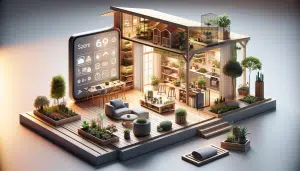You Can Make Your Home Greener and Save Resources
Lily Carter September 24, 2025
Discover practical ways to create a greener home and garden—improve energy efficiency, reduce waste, and tap into sustainable gardening methods that benefit both your living space and the planet. This actionable guide explores simple upgrades, eco-friendly materials, and mindful routines for a thriving and sustainable lifestyle.
Simple Upgrades for an Energy Efficient Home
Energy efficiency is at the core of a sustainable home. Swapping out incandescent bulbs for LED lighting is a small change but yields noticeable reductions in electricity consumption. These bulbs last longer, consume less power, and are now available in different colors and fixture types. Insulating attics, doors, and windows shuts out drafts and helps keep the temperature stable all year long. This upgrade supports reduced reliance on heating and air conditioning, leading to significant energy savings. Minor fixes, like using weather stripping or foam seals, further enhance this effect and are often inexpensive.
Appliances play a pivotal role in your home’s ecological footprint. Choosing Energy Star-certified devices, such as refrigerators, washing machines, and water heaters, ensures consumption stays within efficient thresholds. Smart thermostats make it easier to regulate heating and cooling, even learning your schedule or adjusting remotely. These intelligent systems take the guesswork out of energy management, supporting a greener household without sacrificing comfort.
Reducing energy doesn’t stop at devices; it’s also about behaviors. Many households find savings by unplugging unused electronics to avoid phantom power or by adjusting daily routines around natural light and temperature. Automated blinds, ceiling fans, or zone-based lighting can further tailor energy use to activity, minimizing waste. Embracing these changes supports both environmental and financial well-being (Source: https://www.energy.gov/energysaver/energy-saver).
Creating a Water-Wise Environment Indoors and Out
Water conservation is essential, especially in the garden where irrigation can account for a significant portion of household usage. Installing a rain barrel or similar harvesting system allows for the collection and reuse of rainwater for plants and landscaping. These systems are simple to set up, requiring only a downspout and a secure barrel. The captured water is chemical-free and supports a thriving garden even during dry spells. Plants flourish, and local water resources are preserved.
Inside the home, water-saving fixtures like low-flow showerheads and dual-flush toilets deliver immediate results. Front-loading washing machines use less water than top-loading counterparts and can be paired with efficient detergents to increase their impact. Simple habits, such as turning off the tap while brushing teeth or running dishwashers only when full, add up over time. These small efforts safeguard valuable water supplies while lowering utility bills (Source: https://www.epa.gov/watersense).
Landscape design also matters. Selecting drought-tolerant plants, installing drip irrigation, and using mulch in gardens all contribute to lasting water efficiency. Mulch retains soil moisture, suppresses weeds, and reduces evaporation, making it a practical tool for both flowerbeds and vegetable patches. Thoughtful plant groupings can create microclimates that further minimize watering needs, contributing to a landscape that thrives with less intervention.
Sustainable Gardening Techniques for Every Yard
Sustainable gardening starts with soil health. Incorporating compost enhances nutrient content and structure, creating a fertile ground for plants while minimizing food scraps sent to landfills. Compost bins and worm farms can be established even in small spaces, turning kitchen waste into valuable organic fertilizer. The resulting soil amendment supports vegetable gardens, ornamental beds, and lawns equally, improving drainage and root development (Source: https://www.epa.gov/recycle/composting-home).
Opt for native and pollinator-friendly plants. These species typically require less water and fertilizer and are better adapted to the local environment. By attracting bees, butterflies, and birds, you also support the broader ecosystem. Organic gardening methods—like hand weeding, crop rotation, and natural pest deterrents—reduce chemical use and create safe zones for beneficial insects. Adopting these habits can result in healthier, more resilient gardens.
Garden layout can make maintenance easier and more sustainable. Raised beds allow efficient use of compost and water. Companion planting—matching plants with synergistic qualities—helps deter pests and can increase yields. Perennial vegetables and shrubs provide recurring harvests and stabilizing roots that protect the soil. Each feature contributes to a low-impact, productive, and inviting outdoor space.
Embracing Eco-Friendly Materials for a Healthier Home
Eco-friendly materials are increasingly easy to find and integrate, whether in renovations or daily living. Bamboo flooring, recycled glass countertops, and reclaimed wood bring unique textures with a fraction of the environmental toll of new materials. Paints and furniture marked as low-VOC (volatile organic compounds) minimize pollutants, contributing to better indoor air quality. Making these choices invests in well-being while supporting responsible sourcing and production practices.
In the garden, consider biodegradable pots, natural mulches, and locally sourced stone or wood. These materials break down without lingering toxic residues and often cost less in the long term. Recycled plastic lumber for decking and benches diverts waste from landfills, extending the useful lifecycle of existing resources. Many of these choices are modular and can be updated or repaired with ease, extending the lifespan of gardens, patios, and homes.
Sourcing matters too. Homeowners are turning to community-based resources—like salvage yards and upcycling networks—to find reclaimed fixtures and construction materials. Some choose to donate excess materials to nonprofits rather than discarding them, fostering a cycle of sharing and reducing demand on new production. These collective actions enhance the community and ease the planet’s burden (Source: https://www.greenbuildingadvisor.com).
Waste Reduction and Composting at Home
Waste reduction starts with mindful purchasing and extends through to disposal. Choosing items with minimal packaging or those made from recycled materials is an effective first step. In the kitchen, reusable containers and cloth shopping bags reduce reliance on disposable plastics. When leftovers occur, creative meal planning and freezing help avoid spoilage and food waste. This intentional approach conserves both money and resources and reduces the volume sent to landfill.
Composting is a powerful tool for recycling organic matter. Beyond fruit and vegetable scraps, eggshells, coffee grounds, and yard cuttings can all be included. Modern countertop composters make the process clean and manageable even in urban apartments. The output, when spread in gardens or potted plants, revitalizes soil and promotes healthy growth. Communities with municipal composting programs encourage participation by offering bins and regular collection, extending these benefits citywide (Source: https://www.nrdc.org/stories/composting-101).
Recycling complements composting by diverting glass, metal, and paper from trash bins. Sorting materials correctly means more of them are returned to the supply chain rather than ending up in landfills. Many neighborhoods provide easy guides or apps to clarify what can be recycled and where to take hazardous items. This community-wide participation makes a measurable impact, supporting a closed-loop, low-waste lifestyle.
Daily Habits That Build Greener Lifestyles
Building a sustainable home starts with daily routines. Turning off lights when leaving a room, batch cooking to save energy, or air-drying laundry are habits that, when adopted widely, significantly reduce a community’s carbon footprint. Even walking or cycling for short errands preserves fuel and improves personal health. These habits anchor a green mindset and set a positive example for neighbors and guests alike.
Mindful consumption is key. Questioning new purchases, choosing quality over quantity, and supporting eco-conscious companies can shift demand toward sustainable practices. Sharing—through tool libraries, communal gardens, or clothing swaps—builds resilience, conserves resources, and fosters a strong sense of camaraderie. These habits enhance well-being as much as the planet, making them doubly rewarding (Source: https://www.sierraclub.org/home-living-green).
Participation in community clean-ups or tree-planting events further stretches impact beyond the home. These activities restore green spaces and often lead to lasting friendships and local pride. Staying informed about new research and incentives—like rebates for solar panels or discounts on native plants—enables ongoing improvement without overwhelm. Sustainability becomes a journey, marked by small, meaningful steps.
References
1. U.S. Department of Energy. (n.d.). Energy Saver Guide. Retrieved from https://www.energy.gov/energysaver/energy-saver
2. U.S. Environmental Protection Agency. (n.d.). WaterSense. Retrieved from https://www.epa.gov/watersense
3. U.S. Environmental Protection Agency. (n.d.). Composting At Home. Retrieved from https://www.epa.gov/recycle/composting-home
4. NRDC. (n.d.). Composting 101. Retrieved from https://www.nrdc.org/stories/composting-101
5. Green Building Advisor. (n.d.). Green Materials. Retrieved from https://www.greenbuildingadvisor.com
6. Sierra Club. (n.d.). Home Living Green. Retrieved from https://www.sierraclub.org/home-living-green







